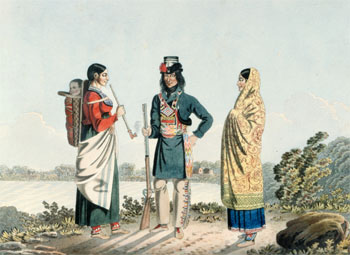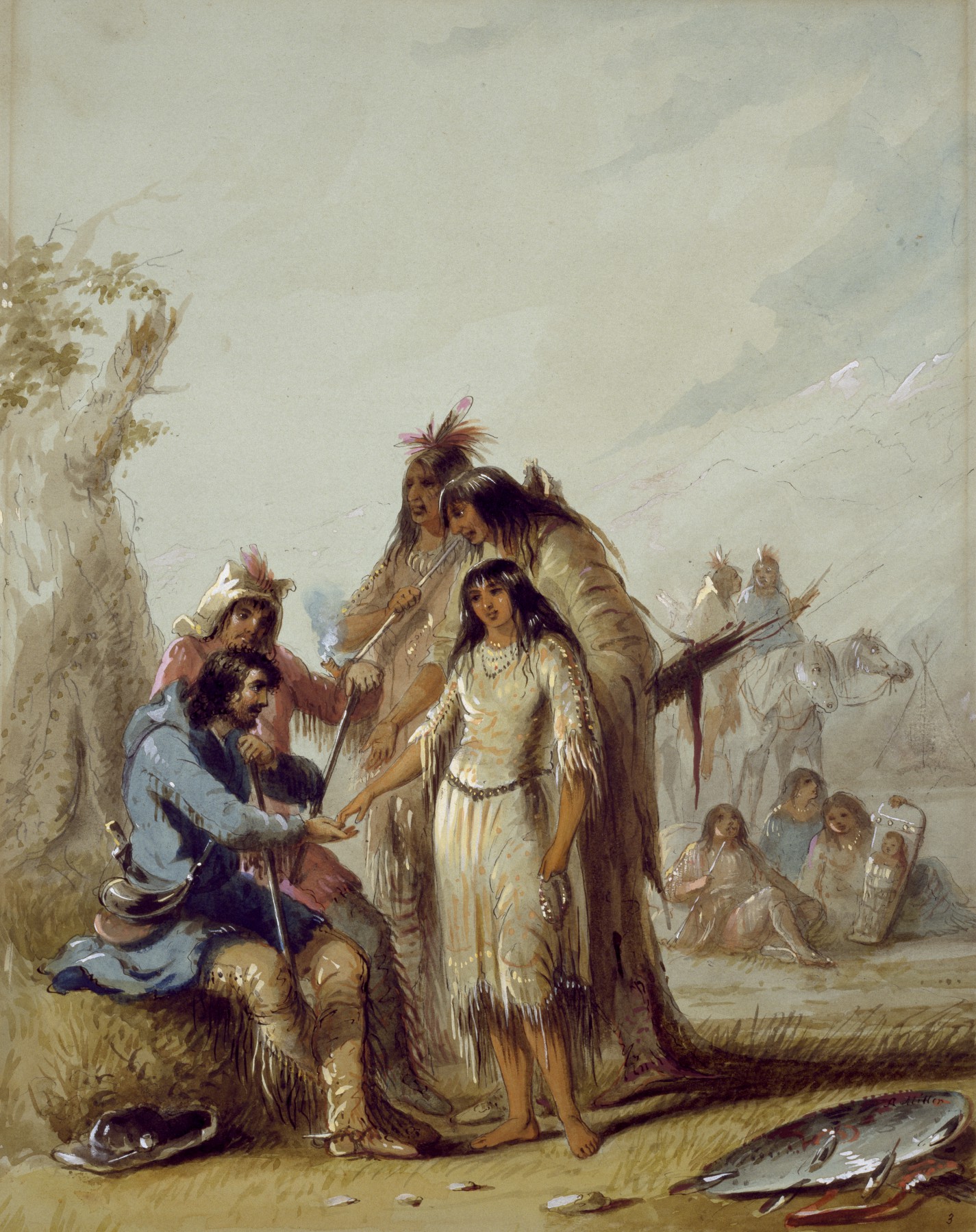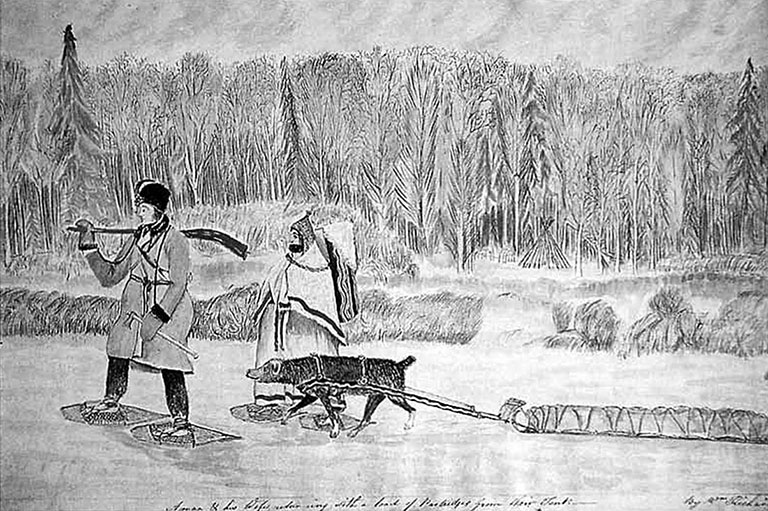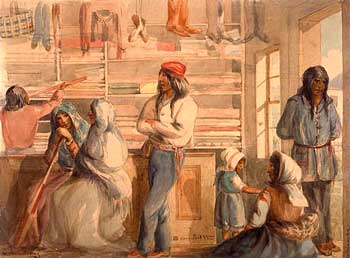Thanks to Beth Hynes-Ciernia for permission to reprint her article, “Women in the Fur Trade” (La Compagnie Journal, Vol 2 No 2 (1988), page 13) in honor of Women’s History Month. The US has celebrated women’s contributions to history, culture and society annually throughout the month of March since 1987.
During the fur trade, marriage a’ la facon du pays, or marriage in the manner of the country, was a marital relationship between Native women and European fur traders, based on Native cultural norms and local customs rather than European ones. Although sometimes temporary, such marriages often lasted a lifetime with or without a Church blessing.
There’s a tendency to think of these marriages as casual liaisons established (and abandoned) wherever the men happened to be working. Yet, promiscuity apparently was not the norm in fur trade society. In fact, relationships between Native women and fur traders probably focused more on building strong family relationships.
In looking at marriage within the fur trade we must keep in mind that fur trade society wasn’t uniform. Different companies had their own rules regarding marriage between their employees and Native women which changed over time. Native groups also had distinct social norms and different contacts with Europeans which influenced their behavior. Still, a study by Sylvia Van Kirk (published in the book Many Tender Ties) demonstrates that “the norm for sexual relationships in fur-trade society was not casual, promiscuous encounters, but the development of marital unions which gave rise to distinct family units.”
Generally, the best interests of both parties were served. Very simply put, fur traders gained helpmates to cement alliances and make a monotonous life more bearable; Native Americans were offered a way of life which placed them in an important position politically and which was richer materially.
Yet the services of Native women (beyond any sexual involvement) were essential to the smooth running of the fur trade. They served as cultural and linguistic interpreters; they trapped small game and fished (and on more than one occasion were responsible for providing the only food available at a post, thus saving the men from starvation). They sewed moccasins, netted snowshoes, and made pemmican. They prepared the skins for shipment and made clothing. They cleaned and washed and, in later years, cared for large gardens at many posts.
A brief comparison between the North West Company (NWC) and Hudson’s Bay Company (HBC) serves to highlight some typical differences. The NWC continued the French practice of extensive intermarriage, and all ranks (bourgeois, clerk, and engage) were permitted to marry a’ la facon du pays. The daughters and sons of these unions also intermarried across class lines. One journaler, Ross Cox, writes that Louis La Liberte, a voyageur, apparently addressed one of the company’s proprietors with “familiarity,” because three of his daughters had married wintering partners.
The HBC officially frowned on intermarriage, however, the economic and social pressures were so strong that many officers bent the rules. While London finally altered its stance regarding officers marrying a’ la facon du pays, it was only partially successful in limiting marriage in the upper ranks of the companies. Anxious to retain those who could stand the rigors of a long tenure in the interior, the HBC was forced to turn a blind eye to these indiscretions, creating a hypocritical two-tiered system.
By the early decades of the 1800’s, customs and rules had changed regarding marital relations. Not only did the companies have different concerns, but many Native Americans had become disillusioned and offended by some of the fur traders’ behavior. During this time a group of marriageable women, ideally suited to be fur trade wives, had grown large enough to supplant the full-blooded Indians. This group was the métis, or mixed bloods. They were specifically included as permissible mates in the NWC’s resolution of 1806, which forbid marriages to full bloods.
Thus, another stage in the changing world of fur trade society had begun.

A Métis Man and His Wives, 1828, by Peter Rindisbacher. The first Métis were the offspring of “country marriages” between voyageurs and fur traders and Native women. (courtesy Library and Archives Canada/Acc. No. 1973-84- 1)

The Trapper’s Bride, 1858-59, by Alfred Jacob Miller. “The scene represents a trapper taking a wife or purchasing one. The prices varying in accordance with circumstance. The trapper is seated with his friend, his hand extended to his promised wife, supported by her father and accompanied by a chief, who holds the calumet, an article indispensable in all grand ceremonies.” (Courtesy The Walters Art Museum)

A Man & his Wife Returning with a Load of Partridges from their Tent, c.1807, by William Richards. Though the Hudson’s Bay Company actively encouraged celibacy among its employees in its Canadian operation, in reality its orders in this regard were rarely obeyed. (Hudson’s Bay Company Archives / p.116)

Inside the Trading Post, Fort William, 1860-1870, by William Armstrong,
Recommended reading:
- Brown, Jennifer S. H.. Strangers in Blood; Fur Trade Company Families in Fur Trade Country. University of Oklahoma Press; Oklahoma. 1996.
- Huck, Barbara. “Love in Another World.” Canada’s History, 14 February 2017. Canada’s History Society. https://www.canadashistory.ca/explore/settlement-immigration/love-in-another-world. Accessed 31 March 2019.
- Macdougall, Brenda (2008).”The Comforts of Married Life’: Metis Family Life, Labour, and the Hudson’s Bay Company.” Labour/Le Travail (61): 9–39.
- Sleeper-Smith, Susan. Indian Women and French Men: Rethinking Cultural Encounter in the Western Great Lakes. University of Massachusetts Press; Boston, Massachusetts, 2001.
- Van Kirk, Sylvia. Many Tender Ties: Women in Fur-trade Society, 1670-1870. Watson & Dwyer Publishing, Ltd., Winnipeg, Manitoba. 1996.
- White, Bruce M. (1999). “The Woman Who Married a Beaver: Trade Patterns and Gender Roles in the Ojibwa Fur Trade.” Ethnohistory. 46 (1): 130–138.

